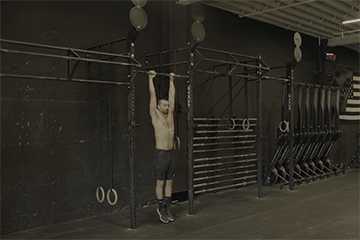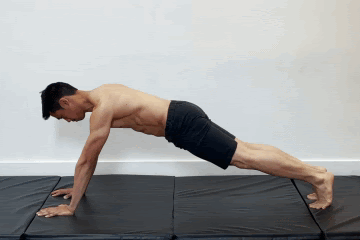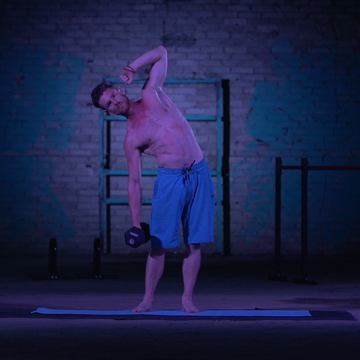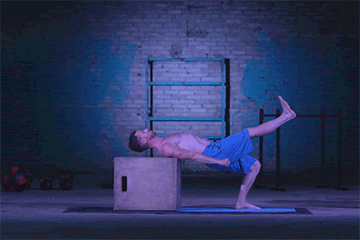
Join the tribe of Movement & Calisthenics Athlete – People just like you that are working with their own body weight to get strength, lose fat build muscle, recover from injuries and live their best lives!
A strong and healthy body manifest in a symmetrical physique.
Not only it would look good and proportional, but it’s also functional and free from pain!
Muscle imbalances are one of the most overlooked causes of pain. For example, tight muscles on one side can lead to back or neck pain while weak lower back muscles can cause shoulder and glute pain. In addition, literature shows that imbalance muscle and tendon development results in a higher risk of tendinopathies.
With the main focus on our fitness goals such as losing fat, building muscle, learning skills, it’s easy to create proportional imbalances as we favor working on our favorite exercises and body parts.
This blog post will talk about how muscle imbalances happen and how you can fix them. We’ll also discuss what you should do to avoid muscle imbalance and how to correct them through movement!
What are muscle imbalances?
Favoring one side
To simply put it, it’s when one side becomes much stronger than its opposing partner (such as bicep vs tricep).
But, a muscular imbalance is more than just having a weaker side. It’s having a large disparity between certain sides of a muscle group. It can be the left arm vs the right arm size and strength. It can also be having weaker pulling strength compared to your pushing strength.
If you don’t have an underlying medical condition, muscle imbalance occurs to improper training protocols which can exacerbate current differences in musculature development. Favoring a dominant side can easily develop muscle imbalances.
As it turns out, our muscles are not all created equally. When you exercise or work hard at your job, some muscle groups will get stronger and other muscle groups will become weaker. This leads to the uneven development of the body which can lead to pain in certain areas.
Here are potential causes of muscle imbalances:
- Repetitive daily activities
- Lack of activity
- Bad posture
- Prolonged sustain positions
- Improper training program
- Bad exercise habits
- Individuality
Why fix muscle imbalance?
It’s impossible to achieve perfect balance throughout our body but we SHOULD STILL strive to improve these imbalances as it can result in
-
- Unbalance physique – Aesthetically speaking, it will look better if you are well balanced. That’s why many people aim to make the calves grow larger to balance the upper body size which is easier to grow.
- Pain – Pain is a signal that there is something wrong with your body. One potential cause is an imbalance which you can still treat and prevent in the future.
Lack of mobility – Mobility refers to the range of motion you can control to display your strength. For example, if you’re only training with an extended wrist such as in a push-up position, you might neglect your flexor muscles which can eventually decrease your wrist mobility and develop pain over time. If you’re interested in wrist mobility check out this article: Ultimate Wrist Mobility
Train your weaknesses
The most obvious fix and prevention of muscle imbalance is to simply do the work where you are weak.
People tend to train and favor their strongest exercise, body part, or movement because it displays their strength. Unfortunately, this leads to lagging body parts, even larger muscles groups aren’t safe from this risk.
A very common example is doing leg day. Calisthenics athletes are popular for having amazing core and upper body strength, but weak, skinny legs.
There are two things in this matter:
- High-level skill-based calisthenics athletes still train their legs but minimize the leg size to maximize their skill performance. Not much problem with this one.
- Athletes that just don’t train their legs enough because it’s boring or doesn’t align with their goals.
There’s no reason for you NOT to train your legs unless you have a severe injury that requires full complete rest. If not, address your weakness and you can even grow your legs without any equipment.
The same thing goes for other muscle groups such as back muscles for pulling movements. If you’re weak with pull-ups, train it. Don’t avoid it.
Always include the fundamental exercises but also add extra exercises that can address specific weaknesses and that hit the opposing muscle groups.
Common weaknesses are hip flexors, rotator cuffs, wrists, elbows, adductor muscles, lower back, and the legs in general.
But also don’t be too confident with your larger muscle groups. Always aim for general, balanced development before working on specificity.
Unilateral exercises
Archer push-ups are a good unilateral exercise that’s part of the one-arm push-up progression.
Unilateral exercises are the obvious solution for muscle imbalance. It allows you to focus on the weak side of your body while still developing your dominant side.
Unilateral exercises are exactly what you need to eliminate muscle imbalance by targeting a specific part at a time. A 2018 research also suggests that you also get to strengthen the opposite limb you are working on during unilateral movements. It’s a win-win situation!
The best way to implement unilateral exercises is, to begin with, the weak side of your body first before doing the dominant side.
So for example, if you’re training single-arm bodyweight row and you’re right-handed, start with the left side first before proceeding to the right side. This allows you to focus all of your effort and energy on the non-dominant side which can be difficult.
The recommended way to fix muscle imbalances in a program structure is as follows:
Begin your workout with the major unilateral compound exercises ( for example, inclined one-arm push-ups, assisted one-arm pull-ups, one leg squats) at the start of your workout. This helps you address the muscle imbalance and focus all your efforts towards fixing the issue while you are fresh.
The next step is to do the bilateral exercises so you can integrate the movement with your dominant side and weak side of your body as one. Bilateral exercise (if not done correctly) tend to use more of the dominant muscle group so beginning your workout with the compound unilateral primes your muscles better for balanced training.
Finish your workout with unilateral isolation movements. Isolation exercises tend to be lighter with more focus on more training volume.
Take note of working the muscles equally as unilateral work, if done incorrectly, can develop larger muscle imbalances.
Muscle-Preactivation
Scapula retraction develops the initial pull for the pull-up progression.
The easiest way to fix muscle imbalances is by targeting different muscle groups and preparing them for the upcoming workout volume. This is done through muscle preactivation.
To perform this type of movement, simply perform warm-ups that target the certain muscles that you will use in the exercise as well as the motion you will be performing.
For more help on muscle preactivation and warm-ups: The Ultimate Calisthenics Guide to Warm-ups
Here are general examples you can perform for the entire body.
Posterior upper body muscles – Banded single arm rows or light dumbbells for rows
Anterior upper body muscles – Banded chest press or light push-up variation with active contractions of the targeted muscles
For shoulders – Light banded or barbell shoulder press
For biceps – Light barbell bicep curls or dumbbell curls, or even banded curls
Posterior lower body muscles – Controlled backward and outward leg swings, Fire hydrants for the upper legs, two-legged or single leg deadlifts
For calves – knee to wall pushes.
Anterior lower body muscles – Controlled forward leg swings, Fire hydrants
The point is using a lighter variation of the exercise that you will be performing and actively contracting the targeted muscles and focusing on the movement pattern.
Preactivating your muscles prior to an actual workout helps improve the mind-muscle connection for more balanced training. Research also shows that preactivation in warm-ups improves training performance which can also be the reason for balanced development.
Muscle preactivation improves strength and muscular development which opens up the opportunity for balanced growth with your muscular weak points.
You don’t need bands or weights if you don’t have access to them as of now. Just use progressions that are easy so you can focus on the activation of the selected major muscle groups.
Preactivation is an easy way to improve your weaker side that you can implement within your warm-ups.
Mind-Muscle connection
Although some exercises do already have specifically targeted muscles, being attentive to the mind-muscle connection can produce even better results.
Your beautiful mind plays a massive role in improving your weaker side as well as building muscle and strength.
We’ve already mentioned this term in the first part of the article. The mind-muscle connection is actively engaging and contracting your muscles. Thinking about the muscle moving and visualizing its engagement allows for maximum motor recruitment.
This also means not getting distracted with other things when working out or during your break. Avoid listening to podcasts, watching Netflix, or thinking about anything else other than your workout.
Focus allows improved mind-muscle connection which not only builds muscle and strength more efficiently but also improves general movement pattern which avoids the dominant muscle taking most of the load.
It’s such an easy addition to your workout whether you’re fixing imbalances of muscles independently or just trying to improve overall training progress.
Dumbbells
Dumbbells can train muscles independently through isolation exercises to correct a muscle imbalance. Unilateral dumbbell exercise is a fantastic option to strengthen your weaker side that heavily translates to bilateral movement patterns.
One of the biggest mistakes in the workout process is having a black and white mentality of calisthenics only or weight training only.
You can also implement both your own weight and external weights for your resistance training load to maximize your gains in all aspects, especially to eliminate muscle imbalance.
Don’t be afraid to use dumbells to fix the muscular imbalance. Dumbbells offer additional unilateral dumbbell exercises which are perfect for isolating the weaker side and lagging muscle groups.
To correct strength imbalance, switch to dumbbell unilateral counterparts or add additional exercises on top of the bilateral movements you are using.
Dumbbell exercise examples:
Dumbbell curls for bicep weakness if you’re having trouble, especially for chin-ups to improve bicep contribution and engagement.
Dumbbell shoulder press form is quite similar to your pike press which is best for increasing shoulder strength and muscle.
Dumbbell bench press with varying angles of inclinations to target different areas of the chest.
Dumbbell exercise allows muscular engagement independently compared to barbell exercise which has the risk of using one
Just don’t emphasize your already strong body parts as it can make the imbalance worse.
Volume
Training volume is expressed through reps and sets in relation to exercises intensity or how much effort it takes for you to perform an exercise.
Increase training load to help them out of proportion body part to catch up with the rest of the body. It’s a method to induce progressive overload or the principle of how to make your training more difficult to promote growth and development.
To do this, simply add 1 to 5 reps on your weaker side with the unilateral exercises. You may also add an additional set if you have to for the troubled body part. You might expect your stronger side to fatigue slightly slower
Film yourself
Fixing muscle imbalances can be difficult if you’re not even sure how much imbalance is showing in your training programme.
As most of us already have access to a video recorder on our phones, simply filming yourself while you are exercising could show if a muscle imbalance is manifesting on the weaker side of your body.
Choose a few extra exercises just before your main workout or even during your actual workout and check if your form and technique are sound. It’s easy to identify imbalances in the body when performing unilateral exercises, so I recommend you start with them first.
Accept that it’s normal
It’s completely normal to have a dominant and weaker side. After all, the vast majority of us tend to have a bias of one side of our body when moving. Even people who are ambidextrous might have a side of their body that lags behind.
Having a weaker side isn’t a bad thing. It happens and most people all probably have to deal with it.
What matters most is how we correct a muscle imbalance and prevent it from widening the gap. Keep the out-of-proportion body part close to the strength, muscle, and mobility levels of the favored side.
Again, this isn’t limited to the left and right. Everyone might also either favor isometrics vs isotonic (eccentric + concentric) movements or push vs pull.
If you have a weak pull game, get more direct back training so it can keep up with pushing capacity.
It’s impossible to achieve perfect balance but we can also strive to improve these imbalances.
How to avoid muscle imbalances
Making adjustments to your current workout setup now will help you avoid underlying problems whilst greatly minimizing the effects of imbalances.
To avoid this condition, it’s best to keep moving and train your body holistically. This is why calisthenics is such an amazing approach to use for your fitness journey. Calisthenics is a natural way of movement and is focused on holistic, balanced development.
If you want to learn more about why you should be training with calisthenics, check out the article below:
Is Calisthenics really a better way to train? Calisthenics PROs and CONs
You can also use the fixes above to prevent muscle imbalance in the first place. It’s all about staying active and working on your weaknesses.
Take away
Moving with an imbalance that’s too evident can cause a massive disturbance in your life. Not only does it look bothering, it can also result in pain, mobility issues, and frustration if not addressed immediately.
Working smarter with your training program is ideal to minimize wwidening the gap and preventing any imbalances from happening in the first place.
If you’re interested in working with a holistic approach that covers all the necessary elements for a well-balanced body that’s looks good and can move well, then a personalized program is the best way to go.
If you’re interested in the taking your fitness journey to the next level, knowing what your body is capable of is the first step.
Determine your strengths and weaknesses so you can move forward with a personalized training program.
TAKE THE ASSESSMENT NOW!









